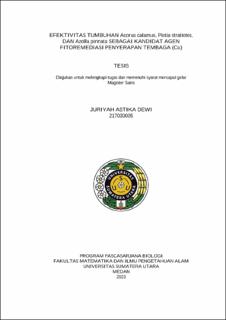| dc.description.abstract | Metals are dangerous pollutants because they cannot be degraded in living bodies. Excessive amounts of metal can turn toxic. The purpose of this study was to determine the effectiveness of the Acorus calamus, Pistia stratiotes,and Azolla pinnata as candidates for Copper metal phytoremediation agents. This study used a completely randomized factorial design consisting of 2 factors, first plant absorbent materials consisting of 3 species Acorus calamus, Pistia stratiotes, and Azolla pinnata and second copper concentrations of 2 and 5 mg/L. Data analysis was carried out using the ANOVA and continued with the average difference test. The results of this study indicate that three plants Acorus calamus, Pistia stratiotes, Azolla pinnata can reduced Cu metal in water. The Acorus calamus plant can reduce Cu levels in the water at a concentration of 2 mg/L to 96,85% and a concentration of 5 mg/L to 96,80%. Pistia stratiotes plants reduced Cu levels in water at a concentration of 2 mg/L to 96,50% and a concentration of 5 mg/L to 99,94%. The Azolla pinnata plant reduced Cu levels in water at a concentration of 2 mg/L to 98,50% and a concentration of 5 mg/L to 96,54%. The highest BCF value at a concentration of 2 mg/L in Azolla pinnata was found in the roots 6,77 mg/L and the highest in leaves 8,88 mg/L. The highest BCF value at a concentration of 5 mg/L in Pistia stratiotes plants is found in the roots of 2,26 mg/L and the highed in leaves is 2,46 mg/L. The highest TF value of 2 mg/L concentration in Azolla pinnata was 1,31 mg/L and the highest TF value of 5 mg/L in Acorus calamus was 1,98 mg/L. | en_US |





